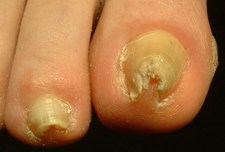 Nail fungus, also known as onychomycosis, is a fungal infection of the fingernails and toenails that causes discoloration, thickening, and often softening of the nails.
Nail fungus, also known as onychomycosis, is a fungal infection of the fingernails and toenails that causes discoloration, thickening, and often softening of the nails.
The incidence of onychomycosis has been reported to be 2-13% in North America. Onychomycosis affects persons of all races, and it affects males more commonly than females, and adults are 30 times more likely to have onychomycosis than children. Toenails are much more likely to be infected by fungus than fingernails. The incidence of onychomycosis has been increasing over the years and is related to diabetes, a suppressed immune system, and aging.
Nail fungus (onychomycosis) is caused by three main classes of fungal organisms: dermatophytes, yeasts, and nondermatophyte molds. Dermatophytes are, by far, the most common causes of nail fungus in Minnesota.
There are many subtypes of nail fungus. These subtypes of onychomycosis can be identified based on where the infection appears to be located relative to the structure of the nail. The most common form of nail fungus in Minneapolis and St. Paul areas is distal subungual onychomycosis, the others are white superficial onychomycosis, proximal subungual onychomycosis, candidal onychomycosis, et al.
If you have a suppressed immune system due to medications, diabetes or other conditions such as, AIDS, leukemia or have had an organ transplant, you are at more serious risk for an infection that can spread beyond your toe nails.
The common risks and complications associated with nail fungus are deformity, pain, emotionally distressing, spreading of the fungual infection, and cellulitis with a bacterial infection.
People with onychomycosis may experience significant psychosocial problems due to the appearance of the nail. The most common symptom of a fungal nail infection is the nail becoming thickened and discolored. A nail fungus infection may begin as a white or yellow spot under the tip of nail. As it spreads deeper into your nail, it may cause nail discoloration, deformity, and loosening or lifting up of the nail. It is usually not painful or other bodily symptoms.
Nail fungus can be treated many ways in Minnesota. The treatment options for nail fungus include Laser treatments, oral or topical medications, and nail removal surgery.
There are some things you can do at home to prevent nail fungus.
- Clean your sheets in hot water and dry them on high heat.
- Wear socks that are made of natural fibers and not synthetic material.
- Make sure your feet are dry and not in a warm and moist environment.
- Don’t use a nail polish or gel or acrylic nails until the fungus has completely cleared up.
- Don’t walk barefoot in public places.
- Using a Sterishoe UV light to sterilize your shoes.
- If you have skin fungal infection, treat it before spreading into nails.





